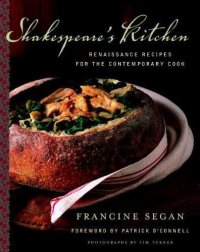
Ebook: Shakespeare's Kitchen: Renaissance Recipes for the Contemporary Cook
- Year: 2011
- Publisher: Random House
- Language: English
- epub
From Publishers Weekly
According to food historian Segan, we inherited much of what we now think of as "American" food from the English: "The Pilgrims who arrived at Plymouth Rock were Shakespeare's contemporaries and they brought their cookbooks from England." Updating dozens of classic Elizabethan recipes, Segan leads a culinary foray into Shakespeare's time. Each recipe is supplemented with a historical note that places the dish in context. For instance, Individual Meat Pies with Cointreau Marmalade were served by vendors catering to the theater crowd. The recipes have been adapted for the modern kitchen: all references to cauldrons have been removed. Section titles are in period English (Kickshaws instead of Appetizers, Fysshe instead of Fish, Pottage instead of Soups), but Renaissance scholars are not the only readers who will get a kick out of this book. Its playful tone, fascinating side-notes, and apt citations from the Bard's plays make this book as fun to read as it is to cook from. And for the person who spends time in the kitchen hoping to satisfy curiosity as well as appetite, recipes like Lemony Sweet Potatoes with Dates and Lobster Tails with Wildflowers are sure to appeal. Photos not seen by PW.
Copyright 2003 Reed Business Information, Inc.
From Booklist
Not since Lynne Rossetto Kasper's lauded The Splendid Table (1992) introduced cooks to the world of the seventeenth-century Italian kitchen has a historical investigation turned up so many compelling recipes as has Francine Segan in Shakespeare's Kitchen. Although not a literal gleaning of recipes from Shakespeare's plays and poetry, this volume delves into sixteenth- and seventeenth-century English cookbooks and makes them accessible, reproducible, and attractive. Segan presents each original recipe in its quaint, abbreviated form. Working from that sketchy data, she faithfully converts the antique into instructions that an experienced cook can understand and can reproduce either for a special party or for an adventuresome family. Although reading the original recipe and comparing it with its modern version makes the process look virtually transparent, it's clear that Segan spent hours in a kitchen testing proportions and measurements to make dishes palatable. Simple cauliflower chowder or Italian pea pottage show the Elizabethan fascination with exotic spices such as mace and anise seed. Kids will get a giggle out of the scatological association in the original name of the airy dumplings floating in a thirteenth-century Portuguese soup. Royals watchers will delight in Queen Elizabeth's Fine Cake and the spicy scones named King James Biscuits. Renaissance "Apple" and Steak Pie may serve as a spectacular focus for an elegant dinner party. Segan's appendix gives clever ideas for wording invitations to dinner parties featuring the book's recipes. Students of both history and literature may mine Shakespeare's Kitchen for inspiration for class projects and celebrations. Mark Knoblauch
Copyright American Library Association. All rights reserved